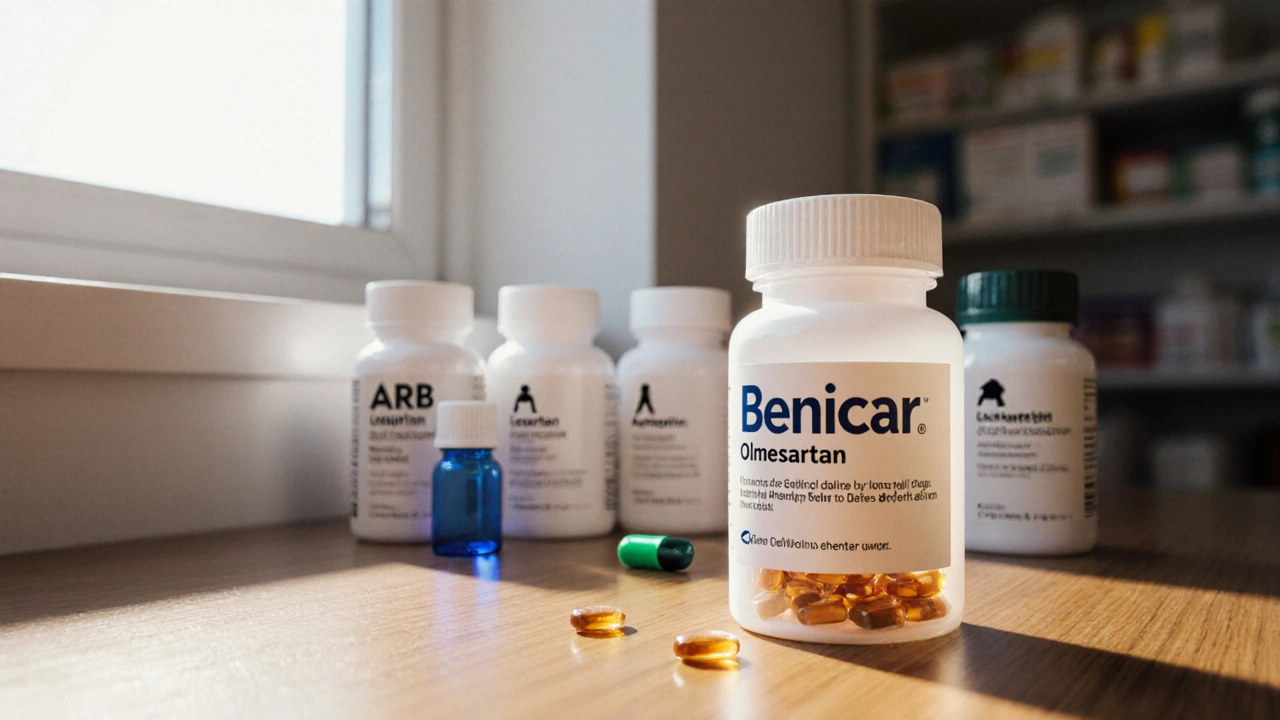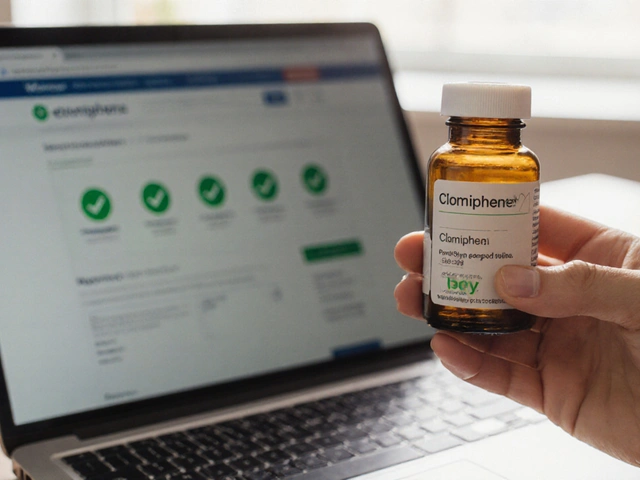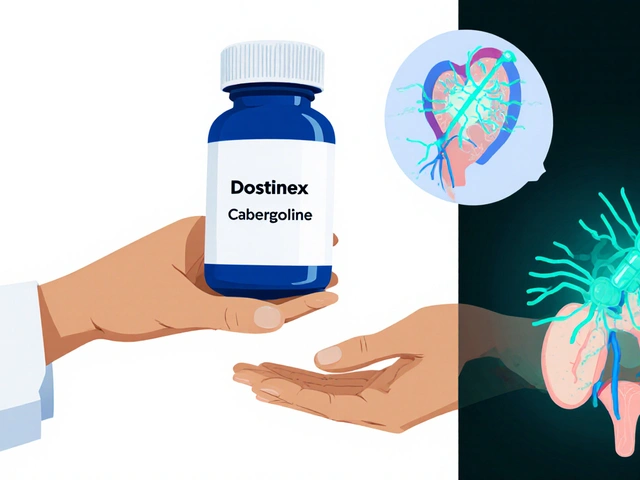Blood Pressure Medication Comparison Tool
Select Medication to Compare
Comparison Results
Benicar (Olmesartan)
Drug Class: Angiotensin Receptor Blocker (ARB)
Typical Dose: 20-40 mg daily
Key Benefits: Strong BP reduction, low cough risk
Common Side Effects: Dizziness, hyperkalemia
Monthly Cost: $60-$90 (brand)
Detailed Comparison Table
| Drug | Class | Typical Daily Dose | Key Benefits | Common Side Effects | Approx. Monthly Cost (US) |
|---|---|---|---|---|---|
| Benicar (Olmesartan) | ARB | 20-40 mg | Strong BP reduction, low cough risk | Dizziness, hyperkalemia | $60-$90 (brand) |
| Losartan | ARB | 50-100 mg | Well-studied, renal protection | Dizziness, back pain | $10-$20 (generic) |
| Valsartan | ARB | 80-320 mg | Longer half-life | Headache, URTI | $12-$22 |
| Lisinopril | ACE-inhibitor | 10-40 mg | Mortality benefit in HF | Cough, angioedema | $5-$12 |
| Amlodipine | Calcium-channel blocker | 5-10 mg | Effective for isolated systolic HTN | Edema, flushing | $8-$15 |
| Hydrochlorothiazide | Thiazide diuretic | 12.5-25 mg | Synergistic when combined with ARBs | Low K+, photosensitivity | $2-$5 |
When it comes to managing high blood pressure, Benicar is a brand‑name drug whose active ingredient is Olmesartan, an angiotensinII receptor blocker (ARB). It lowers blood pressure by preventing angiotensinII from tightening blood vessels. If you’re scrolling through options, you probably wonder how Benicar stacks up against other prescriptions. This guide walks you through the most relevant alternatives, highlights where each shines, and gives you a practical decision‑making framework.
Why a Comparison Matters
Hypertension isn’t a one‑size‑fits‑all condition. Age, kidney function, other meds, and side‑effect tolerance all influence the best choice. By comparing mechanisms, dosing ranges, side‑effect profiles, and cost, you can avoid trial‑and‑error visits and pick a drug that aligns with your health goals.
Key Takeaways
- Benicar (Olmesartan) is an ARB with strong dose‑flexibility and a low cough risk.
- Losartan and Valsartan offer similar ARB benefits but differ in half‑life and pricing.
- Lisinopril represents the ACE‑inhibitor class; it works well for heart‑failure patients but can cause a persistent dry cough.
- Amlodipine is a calcium‑channel blocker, useful when fluid retention or peripheral edema are concerns.
- Hydrochlorothiazide, a thiazide diuretic, is often combined with an ARB to improve control in resistant hypertension.
Core Drug Profiles
Losartan is an ARB approved for hypertension and diabetic nephropathy. Typical doses start at 50mg once daily, titrating up to 100mg.
Valsartan blocks the same receptor as Olmesartan but has a longer half‑life, allowing once‑daily dosing at 80‑320mg.
Telmisartan provides the longest ARB half‑life (≈24h), which can be handy for patients who miss doses.
Lisinopril is an ACE inhibitor that reduces angiotensin‑converting enzyme activity, lowering blood pressure and offering mortality benefits in heart‑failure patients.
Amlodipine is a dihydropyridine calcium‑channel blocker that relaxes smooth muscle in arterial walls, effective for isolated systolic hypertension.
Hydrochlorothiazide (HCTZ) is a thiazide diuretic that reduces plasma volume and peripheral resistance, often paired with an ARB for synergistic effect.
Hypertension affects roughly 1.13billion adults worldwide, with uncontrolled cases linked to stroke, heart attack, and kidney disease.
Side‑Effect Landscape
All antihypertensives carry risk, but the type and frequency differ:
- Benicar (Olmesartan): Dizziness, hyperkalemia, rare sprue‑like enteropathy.
- Losartan: Similar to Olmesartan, plus occasional back pain.
- Valsartan: Upper respiratory infections, headache.
- Lisinopril: Persistent dry cough (up to 20% of patients), angioedema.
- Amlodipine: Peripheral edema, flushing, gingival hyperplasia.
- Hydrochlorothiazide: Increased urination, low potassium, photosensitivity.
Understanding these nuances helps you steer clear of side‑effects that could jeopardize adherence.
Cost & Insurance Considerations
Price often decides whether a patient will stay on a medication. Generic versions of ARBs (Losartan, Valsartan, Telmisartan) are typically $0.10‑$0.30 per tablet, while Benicar’s brand name can be $2‑$3 per tablet without coverage. Lisinopril and Amlodipine generics hover around $0.05‑$0.15. Hydrochlorothiazide is under $0.02. Insurance formularies usually favor generics, so a prescriber’s willingness to write a brand‑name script can impact out‑of‑pocket cost.
Decision‑Making Matrix
| Drug | Class | Typical Daily Dose | Key Benefits | Common Side‑Effects | Approx. Monthly Cost (US) |
|---|---|---|---|---|---|
| Benicar (Olmesartan) | ARB | 20‑40mg | Strong BP reduction, low cough risk | Dizziness, hyperkalemia | $60‑$90 (brand) |
| Losartan | ARB | 50‑100mg | Well‑studied, renal protection | Dizziness, back pain | $10‑$20 (generic) |
| Valsartan | ARB | 80‑320mg | Longer half‑life | Headache, URTI | $12‑$22 |
| Lisinopril | ACE‑inhibitor | 10‑40mg | Mortality benefit in HF | Cough, angioedema | $5‑$12 |
| Amlodipine | Calcium‑channel blocker | 5‑10mg | Effective for isolated systolic HTN | Edema, flushing | $8‑$15 |
| Hydrochlorothiazide | Thiazide diuretic | 12.5‑25mg | Synergistic when combined with ARBs | Low K+, photosensitivity | $2‑$5 |
Best‑Fit Scenarios
- Benicar ideal: Patients needing a potent ARB without the cough associated with ACE inhibitors, especially those with diabetic kidney disease.
- Losartan preferred: When cost is a primary concern and a generic ARB suffices.
- Valsartan useful: For once‑daily convenience in patients with erratic medication habits.
- Lisinopril recommended: For individuals with heart‑failure or post‑myocardial infarction where mortality benefit is critical.
- Amlodipine chosen: When peripheral edema from ARBs is problematic or when systolic pressure dominates.
- Hydrochlorothiazide added: In resistant hypertension or when volume overload is evident.

How to Talk to Your Provider
Bring a short list of priorities: efficacy, side‑effect tolerance, pill burden, and out‑of‑pocket cost. Ask specific questions like, “If I switch from Benicar to a generic ARB, will my blood pressure control change?” or “Can we combine an ARB with a low‑dose diuretic to lower the dose needed?” A collaborative conversation often leads to a tailored regimen that you’ll actually stick with.
Potential Pitfalls & How to Avoid Them
- Assuming all ARBs are interchangeable - subtle differences in half‑life and receptor affinity can affect dose timing.
- Neglecting potassium monitoring - both ARBs and ACE inhibitors can raise serum potassium, especially with concurrent potassium‑sparing diuretics.
- Overlooking drug-food interactions - high‑salt diets blunt the effect of diuretics, while grapefruit juice can increase levels of some calcium‑channel blockers.
- Forgetting adherence aids - using weekly pill boxes or smartphone reminders reduces missed doses, regardless of the drug chosen.
Bottom Line
Choosing between Benicar and its alternatives is less about “which is best overall” and more about “which aligns with your medical profile, lifestyle, and budget.” By weighing mechanism, side‑effect risk, dosing convenience, and cost, you can arrive at a decision that feels right and keeps your blood pressure in check.
Frequently Asked Questions
Can I switch from Benicar to a generic ARB without a doctor’s approval?
Never make the switch on your own. Even though the active ingredient is the same, dose equivalence and timing can differ. Talk to your provider first so they can confirm the proper dose and monitor your blood pressure.
Why do some people get a cough with Lisinopril but not with Benicar?
Lisinopril blocks the enzyme that breaks down bradykinin, leading to bradykinin buildup in the lungs, which triggers a dry cough. Benicar works downstream by blocking the receptor, so bradykinin levels stay normal and the cough is rare.
Is it safe to combine Benicar with Hydrochlorothiazide?
Yes, the combination is common and often sold as a single pill (e.g., Benicar‑HCTZ). It can improve control in resistant hypertension, but you’ll need periodic checks of kidney function and electrolytes.
What monitoring is required when I start an ARB?
Baseline kidney function (creatinine) and serum potassium are checked before starting, then again after 1-2 weeks, and periodically thereafter. Blood pressure should be measured at each visit until stable.
How long does it take for Benicar to lower blood pressure?
Most patients see a measurable drop within 2‑4weeks, with the full effect often reached by 6-8weeks. Consistent daily dosing is key.







October 7, 2025 AT 18:38
Alright, let’s cut to the chase: Benicar packs a punch, but you’ve got cheaper ARBs that do the same job without burning a hole in your wallet. The dosage flexibility is solid – 20 to 40 mg covers most patients, and you won’t be haunted by that annoying cough that ACE inhibitors love to hand out. Sure, the brand name cost $60‑$90 a month, but generic losartan sits comfortably in the $10‑$20 range. If you’re tracking your blood pressure like a hawk, the distinction matters. Bottom line – don’t let the fancy label blind you to the economics.